|
| |
Archives
another trojan horse attack
Some more posts got restored out of existence. Not as bad as before. The political links are gone, however. I guess I will have to put more up.
big food
Our Junk Food Nation
The recent conflict over what America eats is an example of how in Bush's America, corporate interests trump public health.
|
In recent months the major food companies have been trying hard to convince Americans that they feel the pain of our expanding waistlines, especially when it comes to kids. Kraft announced it would no longer market Oreos to younger children, McDonald's promoted itself as a salad producer and Coca-Cola said it won't advertise to kids under 12.
But behind the scenes it's hardball as usual, with the junk food giants pushing the Bush Administration to defend their interests. The recent conflict over what America eats, and the way the government promotes food, is a disturbing example of how in Bush's America corporate interests trump public health, public opinion and plain old common sense.
The latest salvo in the war on added sugar and fat came July 14- 15, when the Federal Trade Commission held hearings on childhood obesity and food marketing. Despite the fanfare, industry had no cause for concern; FTC chair Deborah Majoras had declared beforehand that the commission will do absolutely nothing to stop the rising flood of junk food advertising to children.
| |
[more]
thanks to Bad Attitudes
Why obesity is winning
|
NATIONAL PUBLIC Radio, which Republicans love to flog for ''liberal bias," began a discussion this week about gasoline conservation with: ''When you go to McDonald's or Wendy's, park the car, get out, go in and buy your hamburger instead of sitting at the window, letting it idle."
How American. Get out of the car to save gas. I figure if that happened on the ''liberal airwaves," it demonstrates how junk-food marketeers have conquered the national psyche. This is ironic because the majority of major fast-food chains, including McDonald's, Wendy's, Burger King, Coca-Cola, Pizza Hut, Domino's, KFC, Taco Bell, and their lobbying arms, the National Restaurant Association and the American Beverage Association, give the vast majority of their political contributions to GOP causes. They are the very causes that keep trying to deep-six NPR and the Corporation for Public Broadcasting. Since 1990, the food and beverage industry and its executives have given $247 million to Republicans and $110 million to Democrats.
More important, the politicians do the industy's bidding to enact bans on obesity lawsuits, defeat or water down attempts to provide healthier meals and drinks in schools, and decry any limitations to marketing. The National Restaurant Association, with GOP Senators Mitch McConnell of Kentucky, Rick Santorum and Arlen Specter of Pennsylvania, and John Cornyn of Texas in its pocket, held a press conference in June at which NRA president Steven Anderson said food establishments ''should not be blamed for issues of personal responsibility and freedom of choice."
| |
[more]
thanks to Bad Attitudes
photography
Vintage photo gallery
Take a look behind the scenes in the Consumer Reports testing laboratories. Our research includes documenting our work in photographs, many of which have been published in Consumer Reports magazine over the years. This archive of vintage photographs shows the ingenuity of our testers and traces American consumer products over the decades.

[more]
thanks to consumptive.org
race
Leopard tries for new spots
|
Most southern white Americans who grew up prior to 1954 expected black Americans to conduct themselves according to well-understood rituals of behavior. This racial etiquette governed the actions, manners, attitudes, and words of all black people when in the presence of whites. To violate this racial etiquette placed one's very life, and the lives of one's family, at risk.
Blacks were expected to refer to white males in positions of authority as "Boss" or "Cap'n"--a title of respect that replaced "Master" or "Marster" used in slave times. Sometimes, the white children of one's white employer or a prominent white person might be called "Massa," to show special respect. If a white person was well known, a black servant or hired hand or tenant might speak in somewhat intimate terms, addressing the white person as "Mr. John" or "Miss Mary."
All black men, on the other hand, were called by their first names or were referred to as "Boy," "Uncle," and "Old Man"--regardless of their age. If the white person did not personally know a black person, the term "nigger" or "nigger-fellow," might be used. In legal cases and the press, blacks were often referred to by the word "Negro" with a first name attached, such as "Negro Sam." At other times, the term "Jack," or some common name, was universally used in addressing black men not known to the white speaker. On the Pullman Sleeping cars on trains, for example, all the black porters answered to the name of "boy" or simply "George" (after the first name of George Pullman, who owned and built the Pullman Sleeping Cars).
| |
[more]
camera art
These cameras are an antidote to the funky ones I've been putting together. The navigation, however, is too cute. The red dashes under the page title are links to different pages.
The Art of the Camera
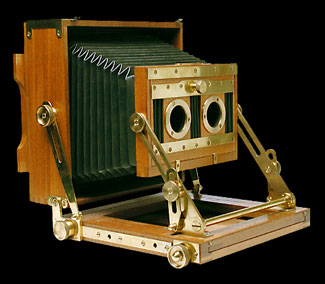
[more]
atheism
SEVENTH DAY AGNOSTICS ARISE: YOU HAVE NOTHING TO LOSE BUT YOUR STEREOTYPE
|
As far as the government and the media are concerned, the world's fourth largest belief system doesn't exist. By one count, In number of adherents it's behind Christianity, Islam and Buddhism but ahead of Hinduism. Globally it's 85% the size of Catholicism and in America just a little smaller than Episcopalians, Presbyterians and Lutherans put together. Perhaps most astoundingly, given today's politics, in the U.S. it is roughly the size of the Southern Baptist congregation. Another count puts it in third place with Buddhism a distant 6th.
Its leaders, however, are not invited to open Senate sessions. Our politicians do not quote them and our news shows do not interview them. And while it is a sin, if not a crime, to be anti-Catholic or anti-Semitic, disparaging this faith is not only permitted, it is publicly encouraged. The media acts as though it doesn't exist. You'd need an exceptional lawyer to sue your employer for ridiculing your belief in it. Its adherents are repeatedly and explicitly excluded from the category of "people of faith" even though they are among the most steadfast and well-grounded in their beliefs. Finally, if one of its major figures dies, you will probably not read about it, let alone find the president, two ex-presidents and Brian Williams flying off for the service.
So completely is this belief system excluded from our national consciousness that we do not even have a name for it. So let's give it one, at least for this article: shafarism - standing for secularism, humanism, atheism, free thought, agnosticism, and rationalism.
Shafars are 850 million people around the globe and at least 20 million at home who are ignored, insulted, or commonly considered less worthy than those who adhere to faiths based on mythology and folklore rather than on logic, empiricism, verifiable history, and science.
This might be considered just another of the world's many injustices were it not for the fact that the globe is currently exceptionally endangered by a madness driven by false prophets of major traditional mythologies such as bin Laden, Bush and Sharon. Seldom has organized religion been so ubiquitously harmful. Even in our own country the dismantling of our republic and its constitution is being led by a extremist Christian cabal that not only is a political travesty but a mockery of its own professed faith.
In short, this is not a wise time for those of alternative beliefs to be banned from the airwaves and the public prints, especially since they have contributed so little to the current troubles.
| |
[more]
thanks to wood s lot
hand held large format
My large format efforts have been focused on the Burke & James view camera but I also want to be able to shoot large format (anything larger than 120 roll film) hand held. I've chronicled my efforts with my 3.25x4.25 Speed Graphic rangefinder. I also have a large format single lens reflex, a Series D 4x5 Graflex. I mentioned it in this post (scroll down.)
I've mentioned the several different format sizes I use or will use. Here is a graphic that shows what they are and their relative size to give a better understanding of the sizes of film these cameras use. The bigger the negative the less it has to be enlarged and the sharper and smoother the prints will be.
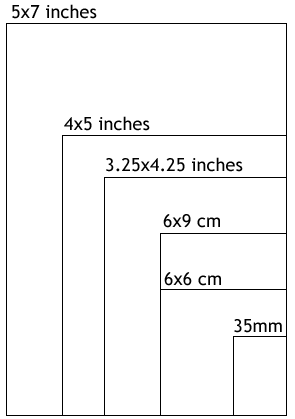
The 6x9, 6x6, and 35mm come in rolls. The others come as sheets.
I thought I would have to do a lot of work on the 4x5 Graflex to make it a user. I thought the back didn't rotate and it used a film back that didn't have any film available for it. Then I saw a 3.25x4.25 Series D Graflex on eBay with several film holders and a rotating back. I got it for $77 which is about 1/3 of what it should have fetched. Good timing. It's a weird size but my Speed Graphic is that size so I already am setting up to process that size.
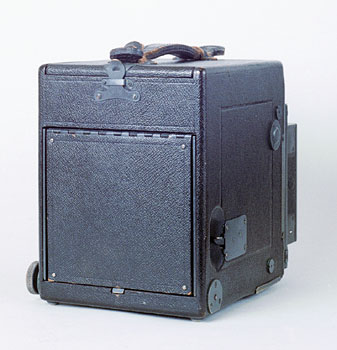
I looks like a box camera with a little strap.
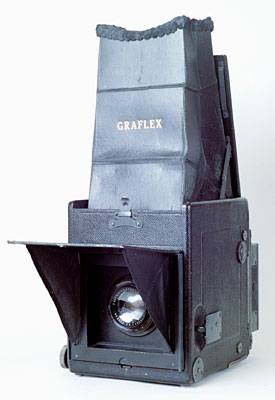
The stovepipe hood looks down on a reflex mirror that pops up when you take the picture. The shutter release is operated by the thumb on your left hand. One of the reasons I was attracted to this camera was the lens. It's a Carl Zeiss Jenna Tessar 150mm f4.5. My 4x5 Graflex has a Carl Zeiss Jenna Tessar 210mm f3.5. Similar lenses that should paint in a similar manner. These Graflexes were probably made in the 1930s.
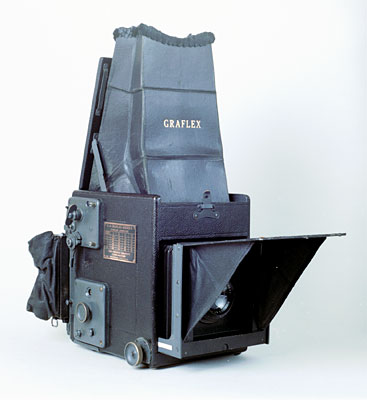
This side shows the upper mechanism that sets the slit size for the focal plane shutter and the lower mechanism sets the tension. It gives speeds up to 1/1,000 of a second. Or it did when new. There will be testing to see what the real speeds are.
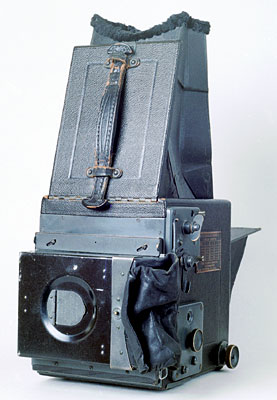
This is the part that blew my mind. It came with 6 normal double-sided sheet film holders. And it came with a bag mag. I had never seen one of these. There is a newer, more automatic, Grafmatic back that holds 6 sheets but these older cut film magazines hold 12 exposures.
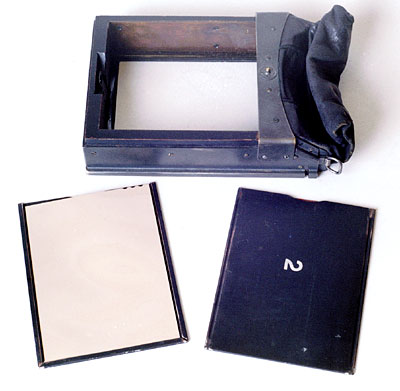
There are 12 metal sheet film holders called septums. You slide a sheet of film in it (in the dark!) and they stack up in the bag mag. Each septum has a number on the back.
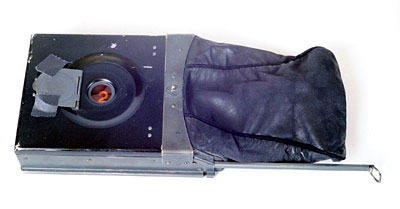
You remove the dark slide and take a picture. Then you pull out the rod which pulls the bottom septum with the exposed film into the bag. You grab the sides of the septum, through the bag, and angle it up and slide it back into the magazine to the top of the pile. I've taped the spring loaded red window cover open so that you can see the number of the exposed septum. You can take all 12 exposures without having to put the dark slide back in.
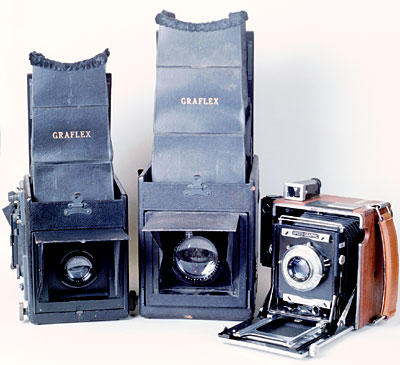
Here is a family picture of my large format hand helds. While the Graflexes are huge, they are pretty light. The 4x5 Graflex is in the middle quite a bit larger. After playing with the smaller Graflex I discovered that the 4x5 Graflex had a revolving back. How I missed that I don't know. I looked on eBay and there were 4 auctions for 4x5 bag mags. The first auction was for two and they went for $54. Too much for me. The next bag mag auction was for one and it went for $53. The power of a good description. The third one went for $30. A good trend. I got the last one for $19.50.
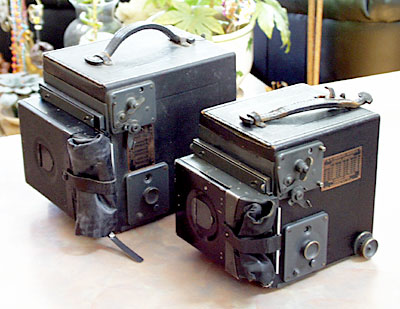
The 4x5 bag mag arrived today. It looks almost new. Here are both Graflexes sporting their bag mags. The 4x5 now really only needs to have the mirror and gound glass cleaned. There is a little more cleaning on the lens, too. If I had known about bag mags I probably wouldn't have gotten the small Graflex. But If I hadn't gotten the small Graflex I wouldn't have known about bag mags. I want to use the big one for portraits and the small one will probaly be a street camera along with the Speed Graphic. Being a SLR the Graflex is better for close in shots and shots that want to be carefully composed. The Speed Graphic is for longer shots and action shots. Did you know that there is also a 5x7 Graflex. Hmmmm.
I should mention that Graflexes were used for some of the most famous street photographs. Dorothea Lange used a 4x5 Graflex for "Migrant Mother". Lewis Hines used a Graflex extensively as did margaret Bourke-White. I think it's still a usefull tool. I'll find out. I'll be shooting 400 film in these cameras. I wish Delta 3200 was available in sheet film. That would be sweet!
Here is some more information on my Series D and the Super D with an an automatic diaphragm.
Graflex RB Series D / Super D
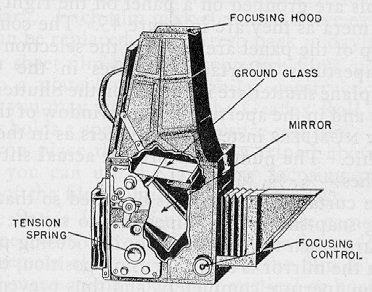
[more]
INSTRUCTION MANUAL
for
Graflex
CAMERAS
RB Super D * RB Series B
|
HOLDING THE GRAFLEX
All Models
The shape of the Graflex and the position of its controls permit it to be held and operated comfortably and without strain. The fact that an erect image is visible in the ground glass, right up to the instant of exposure, further simplifies the handling of the camera.
Rest the camera in both bands, with the fingers under the corresponding front corners of the body (Figure 4). The thumb of the left hand falls naturally on the release lever, while the right thumb and the forefinger are in position to grasp the focusing knob S. To steady the camera, hold it firmly against the chest. To reset the controls after exposure, tilt the camera to the left so it rests on the left hand and forearm.
| |
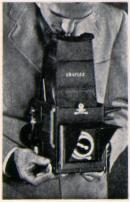
[more]
evolution
Another great post from Pharyngula...
The Cambrian as an evolutionary exemplar
|
I've been reading Valentine's On the Origin of Phyla lately, and I have to tell you, it's a hard slog. This is one of those extremely information-dense science texts that rather gracelessly hammers you with the data and difficult concepts on page after page. I am convinced that James W. Valentine is ten times smarter than I am and knows ten thousand times as much, and it's a struggle to squeeze that volume of knowledge into my miniscule brain pan.
One thing I would like to greatly condense and simplify is his discussion of the Cambrian 'explosion'. Misinterpretation of the Cambrian is one of the many prongs of the creationist assault on science; both old school Biblical creationists and the new stealth creationists of the ID movement have seized upon it as evidence of an abrupt creation—that a Designer poofed the precursors to all modern forms into existence suddenly, and without precursors, and that this observation contradicts evolutionary theory.
It doesn't. Valentine has an excellent diagram that shows how wrong the creationists are.
| |
[more]
lens report
This is a post that got restored out of existence a week ago but I held off on putting it back up because there was another addition and almost two.
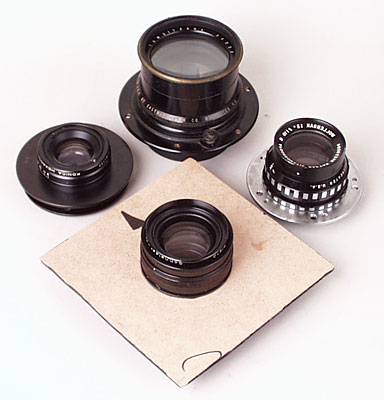
These are the lenses I will be shooting with on the Burke & James. In front is the Schneider G-Claron 210mm process lens that Marja-Leena sent me. On it's left is a 150mm Konica-Hexanon process lens. On it's right is a 330mm Wollensak process lens and in back is a Kodak Anastigmat 540mm process lens from 1944. These are all barrel lenses without shutters and they all will live behind a Packard shutter. The 150, 210, and 330 are all reasonably modern lenses and very sharp. The Kodak is older but promises to be very good. These lenses are very inexpensive. A new lens in a shutter would start at over $700. Marja-Leena took the 210 out of a surplus copy camera and sent to me for postage ($10.50.) The 150mm was $65, the 330mm was $75, and the 540mm Kodak was $28. It has a sticky iris and will need a $40 clean, lube, and adjust from Carol Miller. The others just need a little cleaning and a lens board and they will be ready to go. They are also very light and compact compared to shuttered lenses.
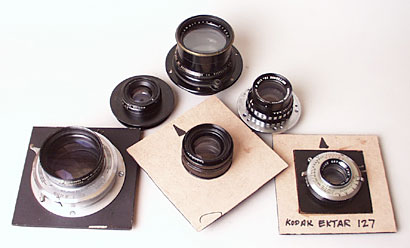
I have two shuttered lenses that I will try. I'm not sure they will really add to the other four. There is the 254mm Elgeet that came with the Burke & James and the 127mm Kodak Ektar from my Speed Graphic.
All these lenses, except for the Ektar, cover 5x7. And since I have three different size backs for the Burke & James, these lenses will have a different angle of view in each format. I have 5x7 (not useable yet), 4x5, and a 120 roll film back that takes 6x9 cm negatives (2 1/4x 3 1/4). Below is a chart that gives the equivalent angle of view of a 35mm camera. I got these numbers from a great spreadsheet at South Bristol Views. It's a frames site so scroll down the anvigation bar to "LF Lens Equivalents". Rummage around in the site. There is some other neat stuff. Notice the chart has a 90mm lens. I will add one of those when the checkbook provides. The darkroom first...
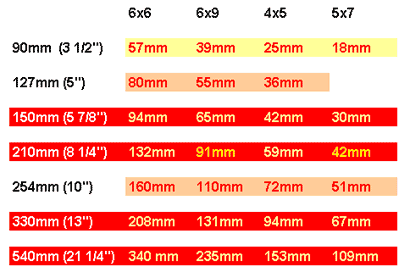
flu
Tomgram: Mike Davis on the Monster at Our Door
|
"Follow that chicken" is not one of the more inspiring lines in the history of detective fiction, nor one of the more frightening in the genre of horror. It's perhaps on the level of that classic grade-Z sci-fi film, Night of the Lepus, in which the giant, rampaging, mutant rabbits were just... well, big bunnies. And yet, don't be fooled, the chicken, probably first domesticated in Southeast Asia some 8,000 years ago, might prove the death of many of us, and for its possible depredations, we are painfully unprepared.
In 1918, a flu epidemic emerged from the trenches of World War I's Western Front -- essentially the war‘s equivalent of the slums -- and swept across the world (twice) ridding it of somewhere between 25 million and 100 million human beings (the equivalent in today's population terms of possibly upwards of a billion people). There have been flu pandemics since, but none faintly on such a scale. For nearly a decade, epidemiologists, public health officials, and veterinary researchers -- by now, in fact just about the whole global medical/scientific community -- have been warning that such a new pandemic is a frightening possibility, if not a near certainty. At the same time, some of them have been performing prodigious genetic detective work as a mutant flu virus, H5N1, has lodged in the systems of wild fowl in southern China, moved into massed domestic fowl populations nearby, and begun to spread to human beings; all the while still genetically evolving in birds (domestic and wild), swine, and even perhaps people, "looking for" the means to leap not just from bird to bird, or bird to swine, or even from bird to human, but from human to human at a staggering rate.
Nothing could more quickly remind us that we humans are part of nature than a flu pandemic; yet three quite unnatural changes in our world have drastically increased the danger of such a pandemic. A livestock revolution has gathered domestic birds together -- think Tyson chickens -- onto giant corporate farms in prodigious numbers, clustering them into what are essentially giant bird slums, where any new disease is guaranteed to spread more easily. Meanwhile, throughout the third world, impoverished human beings have been gathering in far greater urban concentrations than anything imaginable a century ago, and any of these are potential hatcheries for a pandemic. Finally, globalization and global air travel have made the spread of a pandemic, once started, almost instantaneous. In the meantime, H5N1, spreads by an older set of air paths -- avian migration routes -- having just made it to Russia. And we wait.
| |
[more]
burke & james progress report
I'm actually inching closer and closer to shooting large format with the Burke & James. I'm working on a darkroom for film processing and have most of the tanks, hangers, and reels I'll need for 4x5 as well as 120 and 35mm. I need to move a couple of motorcycle frames out of the way and set up an old claw foot bathtub as a darkroom sink. By the time that is done (in another week I hope I hope I hope) I will be shooting some 4x5 Polaroid Type 55 negative/postive. Developing film will follow soon after. I have several rolls of 120 Tri-X to develop in Ilford DD-X. After that I will be trying some Efke 25 and JandC Classic Pan 400 In PyrocatHD and Delta 3200 in DD-X. I have a couple of rolls of 120 coming in the Delta 3200. Developing my own gives me options that I can't get from a lab.
Here are some ads for my Burke & James. The first one is from around 1959 and I found it on the web. The second two are opposing pages in a 1967 Burke & James catalog that I've had since 1973. These are great cameras. Not the most solid or well finished but it has all the movements you could ever want. Mine has both the 5x7 and a 4x5 back. A real working camera. They can be had between $100 and $200 on eBay. I was particularly fortunate to trade 5 rolls of film worth $17.50 for mine. A major score. Good deals can be had.
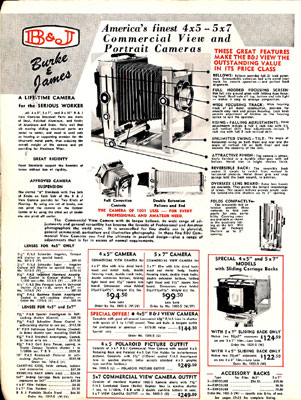
large image
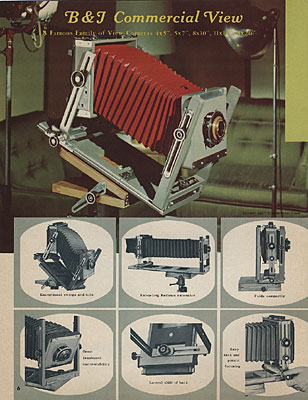
large image
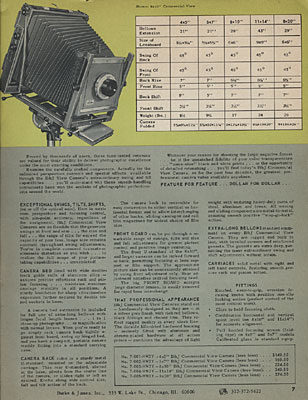
large image
|
|
|
|




















